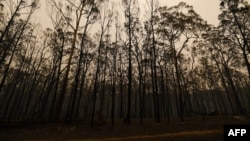Australia’s land and sea wildlife habitats continue to deteriorate due to climate change and other factors, says a report.
The State of the Environment report says Australia has lost more mammal species than any other continent, with the number of new species designated as under threat of extinction increasing by 8% since the last report was issued in 2016.
The report says those numbers rose sharply after the “Black Summer” bushfires of 2019-2020 that burned millions of hectares of land and killed or displaced an estimated 1 to 3 billion animals.
Australia’s average land temperature has risen 1.4 degrees Celsius since the early 20th century.
Land clearing was also listed as a major factor in wildlife losses in the report, with more than seven million hectares cleared between 2000 and 2017 without much of this activity assessed under Australia’s environmental conservation laws.
The iconic Great Barrier Reef suffered mass coral bleaching events in 2016, 2017 and 2020 due to marine heatwaves, the report said. Bleaching occurs when the sea is too warm, for too long, forcing the coral to expel microscopic symbiotic algae that gives it most of its energy and color. A separate report released earlier this year found the reef had suffered a fourth mass bleaching event in 2021.
The State of the Environment is released every five years. The previous conservative government of Prime Minister Scott Morrison received the current report last December, but declined to release it before parliamentary elections that took place in May.
Environment Minister Tanya Pilbersek called the report’s findings “shocking” in a speech Tuesday before the National Press Club. She pledged that Prime Minister Anthony Albanese’s new center-left government will introduce environmental protection laws in parliament next year.
Pilbersek also pledged the government will conserve 30% of its land and sea areas by 2030 and explore the creation of new national parks and marine protected areas.
Some information for this report came from The Associated Press, Reuters, Agence France-Presse.








